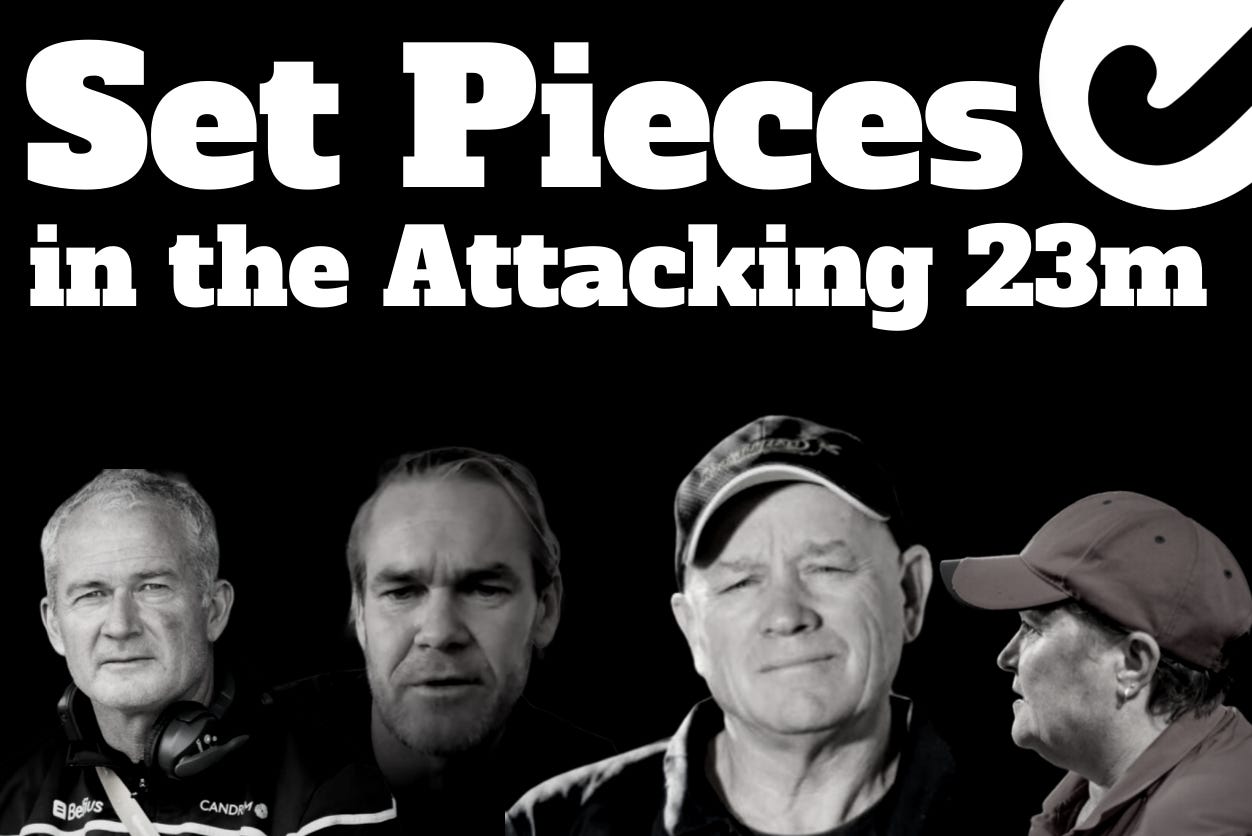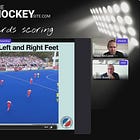Ric Charlesworth: You better spend time on set plays. They’re a big part of the game
Mastering Set Pieces in the Attacking 23m Zone: Principles and Training Approaches for Field Hockey Coaches
Set pieces in the attacking 23m zone, whether free hits or long corners, are pivotal moments in field hockey. They offer structured opportunities to create chaos for the opposition and carve out high-quality circle entries. But as any experienced coach knows, success in these scenarios isn’t about luck, it’s about precision, intent, and training the right principles.
Let’s explore the key principles behind set pieces in the attacking 23m zone, how to train them effectively, for youth teams as well as performance teams. Along the way, I’ll share insights from some of the best minds in hockey coaching, like Alyson Annan, Shane McLeod, and Ric Charlesworth, to ground these ideas in real-world expertise.
Some of the sources used:
Principles of Set Pieces in the Attacking 23m
Before diving into training methods, let’s establish the core principles that should guide your approach to set pieces in this critical area of the field.
Intentionality Over Improvisation
Alyson Annan once said, “We pass the ball to create time and space in the circle. That’s our main objective” . This principle applies directly to set pieces. Every pass, movement, and decision should be intentional, aimed at creating a scoring opportunity or drawing a penalty corner. Random hits into the circle rarely yield results, instead, focus on purposeful play.Space Creation and Exploitation
The attacking 23m zone is all about manipulating the defense. Use your set pieces to stretch the opposition, forcing them to shift and open gaps. As Ric Charlesworth emphasized, “Being unpredictable to the opposition while remaining predictable to your own team is critical” . This balance comes from rehearsed patterns and clear communication.Quick Decision-Making
Set pieces often demand split-second decisions. Whether it’s a self-pass, a quick transfer to the other side, or an aerial, players must recognize opportunities and act decisively. Shane McLeod highlighted the importance of training players to “move through situations quickly, from ball win to counter” . This applies equally to set pieces—train your team to think and act fast.Variety and Adaptability
Predictability is the enemy of effective set pieces. Mix up your approaches: short passes, long aerials, quick self-passes, to keep the defense guessing. As Ric Charlesworth noted, “You always have to be willing to try things while learning from the past”.
Encourage creativity within a structured framework.
Training Set Pieces: Practical Approaches
Now that we’ve established the principles, let’s look at how to train set pieces effectively. These methods are designed to instill the principles above while building technical and tactical proficiency.
1. Free Hits: Earning Circle Entries
Free hits just outside the circle are golden opportunities to create danger. Here’s how to train them:
Rehearse Patterns of Play Develop and practice specific patterns for free hits. For example:
A quick self-pass to draw a defender, followed by a lateral pass to a teammate who drives into the circle.
A disguised pass to a player positioned wide, creating space for a baseline run.
Alyson Annan emphasized the importance of intent: “If you attack without thinking of the end process, you’ll end up in a position where you don’t know what to do” . Train your players to visualize the end goal—a clean circle entry or a scoring opportunity—and work backward to plan their actions.
Train Decision-Making Set up scenarios where players must choose the best option under pressure. For example:
A defender closes down the self-pass—should the player transfer the ball or attempt a 1v1?
The defense shifts to one side—should the ball carrier switch sides or play a quick pass into the circle?
Use small-sided games to simulate these situations and encourage players to read the game.
2. Long Corners: Creating Chaos
Long corners are less structured than free hits, but they’re equally valuable. The key is to create chaos in the circle while maintaining control over your play.
Focus on Quick Restarts
Train your players to take long corners quickly, catching the defense off guard. A fast restart can lead to unmarked players in the circle or a defensive scramble.Use Overloads
Create numerical advantages on one side of the field to draw defenders, then switch play to exploit the space. As Alyson Annan explained, “Attack one side and transition with one pass to the other side, but it has to be done with intent” . Practice these transitions in training, emphasizing timing and accuracy.Rebound Awareness
Not every long corner will lead to a clean shot on goal, but rebounds can be just as dangerous. Train your players to anticipate second and third opportunities, as Alyson Annan suggested: “Rebounding is a second shot at goal. We should celebrate that” .
3. The Self-Pass: When and How to Use It
The self-pass is a powerful tool, but it must be used wisely. Here’s how to train its effective use:
Teach Timing
The self-pass is most effective when it catches the defense off guard. Train players to recognize moments when the defense is disorganized—after a foul, during a substitution, or when defenders are out of position.Combine with Movement
A self-pass is rarely effective in isolation. Train players to use it as a trigger for movement—either their own or their teammates’. For example:A self-pass followed by a quick give-and-go with a teammate.
A self-pass to draw a defender, creating space for a teammate to receive the ball.
4. Switching Sides: When and Why
Switching sides can open up new angles of attack, but it must be done with purpose.
Train Quick Transfers
Practice transferring the ball from one side of the field to the other in one or two passes. This requires precise passing and good positioning. As Alyson Annan noted, “The movement of the ball in the buildup and the attack should lead to the transition and the transfer from left to right” .Recognize Triggers
Teach players to recognize when a switch is needed:The defense is overloaded on one side.
There’s space on the weak side.
The attacking side has run out of options.
5. Aerials: Adding a Vertical Dimension
Aerials can be a game-changer in the attacking 23m zone, but they require skill and timing.
Practice Precision
Train players to execute accurate aerials that land in space or to a teammate. Use drills that simulate game scenarios, such as bypassing a packed midfield or targeting a player making a baseline run.Teach Decision-Making
Aerials are high-risk, high-reward. Train players to assess when they’re the best option:The defense is pressing high, leaving space behind.
A teammate is unmarked in the circle.
The ground passing lanes are blocked.
Games for Set Pieces in the Attacking 23m Zone
Above we explored the principles and training approaches for set pieces in the attacking 23m zone. Now, let’s take it a step further and dive into how to structure practice sessions that effectively incorporate these drills and small-sided games (SSGs). The goal here is to create a training environment that mirrors the complexity of real matches while ensuring players develop the technical, tactical, and decision-making skills needed to excel in these critical moments.
As Andreu Enrich once said:
Small-sided games respect the internal logic of hockey, which is a complex and variable activity.
This philosophy underpins much of what we’ll discuss here. Let’s break it down into:
Structure your Practice Session
Building Up Complexity
Incorporating SSG
Adapting for Youth vs Performance Teams
1. Structuring Your Practice Session
A well-structured practice session balances technical drills, tactical exercises, and game-like scenarios. Here’s a simple framework to follow:









